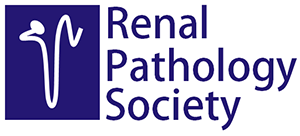Robert Colvin |

ROBERT COLVIN
A brief history of Diagnostic Pathology: Kidney Diseases
In 2008 I was approached by an old friend, Liz Hammond,1 to see if I would be interested in putting together a book on renal pathology. I was happy for a new project, as I had recently retired from being Pathologist-in Chief at MGH in 2006.
A small publishing company, Amirsys Inc., was started in Salt Lake City, Utah by a group of academic radiologists who developed a computer based book series for diagnostic radiology. This series covered all of radiology and was designed to a practical reference for day to day use. The format had standardized headings with bullet text and extensive images. The radiology books soon became the most widely used texts. Amirsys leaders reasoned that a similar approach could be adapted to pathology and recruited Liz to lead the effort. Liz is a dynamic, gregarious, energizing person who quickly convinced others to participate. The Diagnostic Pathology series now has 28 books covering all areas of pathology, a modern version of the Henke-Lubarsch Handbuch of the last century.
I love books and once thought my ideal career would be as a librarian. That didn’t work out, but I treasure all my medical books, in particular the one that taught me renal pathology as a resident, the first edition of Robert Heptinstall’s magnificent 1966 text2. What I liked most about Heppy’s book, other than the succinct, elegant writing, was the integration of clinical and pathological knowledge. That text has continued to be the “Bible” of renal pathology, now in its 7th edition under the extraordinary leadership of Charles Jennette and colleagues.
So why write another book on renal pathology? There were many good books on the subject, in addition to Heptinstall’s. The attraction for me was to develop the most comprehensive text, with every known renal disease included, with up to date, readily accessible information that would help pathologists in diagnosis, investigators in understanding mechanisms, clinicians in care of their patients and all students wishing to learn more about renal disease.
The book was to be available in digital form on the web, and could be searched and downloaded. The writing would be done directly in a computer database, that was formatted for printing and could easily be updated. Each disease was given a separate chapter and each chapter had relevant light, immunofluorescence and electron microscopic findings as well as clinical presentation, pathogenesis, molecular genetics, gross features and differential diagnosis. Key facts were highlighted for easy review and many tables and custom diagrams are provided to synthesize the information. The kidney book would be integrated into a comprehensive series used by pathology residents and faculty.
In 2009 I developed a table of contents and began recruiting authors, drawing on leading young and expert renal pathologists. I was pleased that almost everyone agreed to participate, including many former fellows. There were 11 principal authors in the first edition: Steve Bonsib, Tony Chang, Brad Farris, Lynn Cornell, Joe Gaut, Sanjay Jain, Neeraja Kambham, Helen Liapis, Shane Meehan, Surya Seshan, Alex Vasilyev and me. What a wonderful team! We planned for ~3000 images in the book, so we were scrambling for the photos. We got help from many colleagues who, without hesitation or exception, gave us their best images of the rarest diseases.
We started writing in 2009 but as of September of 2010, we had only 102 chapters completed and 124 left to go before the publisher’s deadline Dec. 31, 2010. The publisher thought we’d never make it. I convened most of the authors at the fall ASN meeting for lunch (there is no such thing as a free lunch). I had made a print out of the chapters completed, which seemed to convince them that the book would become a reality. The author team accomplished the impossible - all chapters were finished by the deadline! The publisher was happy they had a book, the authors were happy that I stopped bugging them, I was happy to return to my life.
One may ask why so many chapters? The answer is that medical research has led to an increasing refinement of disease entities, once categorized by clinical and pathologic characteristics, and now increasingly further defined and separated by etiologic and genetic criteria. The structured format of the book is conducive to presenting this expanding list that will continue to grow in the era of personalized medicine.
Diagnostic Pathology: Kidney Diseases was published in the spring of 2011. It got good reviews (requested from friends), was translated into Spanish and was one of the best sellers for Amirsys. In Laura Barisoni’s basic renal pathology course in Italy, the students gave the book a teaching award.
By 2014, I was eager to do a 2nd edition because there were many suggestions for improvement of the 1st edition and updates were already needed in many diseases. With Tony Chang as co-lead author, we added 25 new chapters and one additional principal author (Chris Larsen), as well as 7 new contributing authors (Nicholas Cossy, Nidia Messias, Christie Boils, Bernie Collins, Marie Claire Gubler, Josephine Ambruzs). We had superb editorial help from Amirsys with the 1st and 2nd editions (especially Dave Chance, who patiently guided us all through the challenges of computer writing). That same year Amirsys was acquired by Elsevier, which opened up more resources and talent, but the format remained the same.
One benefit of a web based version is that the publisher can keep track of the number of views of each chapter, so we could concentrate on updating the most popular ones. Who would have predicted that diabetic nephropathy would be the #1 chapter by web usage!
The 2nd edition was published in 2016. We were particularly pleased that the book received 1st prize in the Pathology category in the 2016 British Medical Association Book Awards.
So, as I write this in February 2019, we have just turned in the 3rd edition to the publisher, whose superb editor, Megg Morin, kept us all in the grove. We added eight more talented authors, Ingeborg Bajema, Evan Farkash, Kammi Henriksen, Michael Mengel, Ian Roberts, Ivy Rosales, Sanjeev Sethi, and Astrid Weins, as well as seven contributing authors (Kerstin Amman, Mariam Alexander, Yasar Caliskan, Linda Hasadsri, Carrie Phillips, Angelica Putnam and Emilie Rijnink). We updated and polished chapters, added 25 more, and shortened some, to keep the book at ~1100 pages. All text, images and references are available on the web, even those which didn’t fit in the print version, which is due to be published in May 2019.
I am proud of this team and their work. In my opinion our book complements Heptinstall’s Pathology of the Kidney and seems to have found its own niche.
My dream is that Diagnostic Pathology: Kidney Diseases will become a communal work product of the RPS in the future and continue for decades. Here’s hoping - and please don’t tell my friend Heppy!
Robert B. Colvin, M.D.
Written at the request of Helen Liapis, RPS Historian
February 13, 20191 Liz and I were post-doctoral fellows together in the early 70’s in Hal Dvorak’s lab at Massachusetts General Hospital and wrote our first R01 together. Liz became the first woman Chair of Pathology at LDS Hospital in Salt Lake City and had an illustrious career, later as a Governor of CAP.
2 In 2011 when a group of us from the RPS visited Heppy in Baltimore to present him with the eponymous Heptinstall Lifetime Achievement Award, I brought my 1966 copy to his house to sign. Heppy, always precise, noted it was the second printing because he was listed as Professor, having been promoted at Hopkins between the first and second printing.



